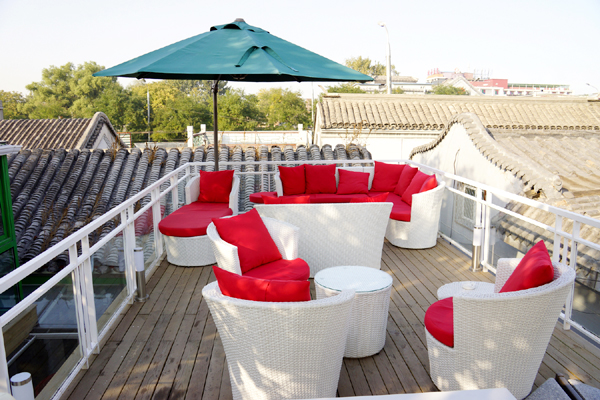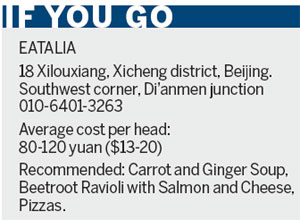An Italian in Beijing
 |
|
The rooftop area of the restaurant blends the meal with sunshine and a view of courtyards. Ye Jun / China Daily |
In the eyes of an outsider, Italian restaurateur Mario Zaccagnini's new endeavor is a walk on the wild side. He has decided to open an outlet of his popular eatery Eatalia right in the heart of Beijing's Ping'an Avenue - a very Chinese district, where the neighbors are Chinese businesses, and where the residents are mostly Chinese.
The young Italian's confidence stems from the success of his first restaurant at Wudaokou, surrounded by universities and close to Zhongguancun, Beijing's Silicon Valley. The restaurant became popular among foreign students and young working Chinese.
"At first, 80 percent of the customers were foreigners. But after a year, the number of Chinese customers grew to one third," he says. "And they brought their friends."
Zaccagnini says the quality and authenticity of Italian food at the new branch is consistent with its older sibling, but while the original branch combines minimalistic decor with contemporary design, he has married the futuristic with Chinese elements at the new outlet.
Green, white and red, inspired by the Italian national flag, are dominant colors.
As a Roman, Zaccagnini loves the feel of ancient things. His new restaurant combines the history of a Chinese courtyard house with the modernity of an Italian eatery.
The restaurant has two areas on the roof above the ground floor. One is a glass patio that allows an abundance of sunlight to filter in, while the other offers al fresco relaxation with comfortable sofas and sunshades during the day. Both areas look out over a patchwork of roofs of courtyard houses, giving it a very Beijing feel.
Although the restaurant is just meters away from a busy crossroad, you cannot hear the traffic. Instead, sparrows chirping on a huge tree spreading over the glass patio give the illusion of being close to nature.
The freshest ingredients are Zaccagnini's main concern. For example, in the carbonara pasta, he insists on using the traditional recipe of egg yolk, cheese and bacon. It would have been easy to substitute with just cream.
On the other hand, the restaurant does try to cater to the local palate. Chefs at Eatalia boil the pasta to suit their Chinese customers. Pasta is hand-made and cooked al dente, which means to the exact point where the tooth is comfortable chewing it.

Zaccagnini would not compromise on ingredients.
"My cream is French. Milk is Swiss. Salmon is Japanese. Ossobuco is Italian. Coffee is South American," he says.
The restaurant bakes a Roman-style pizza with a thin and crispy base with Italian mozzarella served in medium, large and whole tray portions. If you order the whole tray, you can ask for four or five different toppings.
You can start a meal with a nice rice salad with olives, corn, aubergines and ham or a fresh lettuce and chicken salad. Follow up with a warm bowl of carrot and ginger soup. The salmon dishes are exceptional and the quality of the pizza compares to the best five-star hotels. Only at lower prices.
"My goal is to bring real Italian food to China," Zaccagnini says. "I want to offer great food in a good restaurant."
yejun@chinadaily.com.cn














